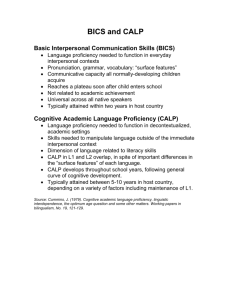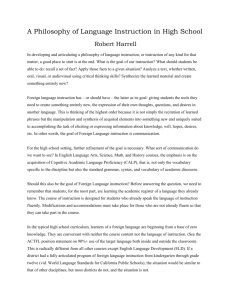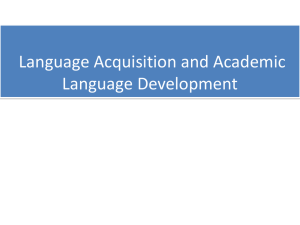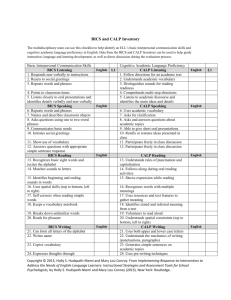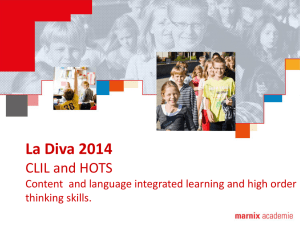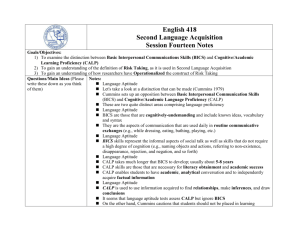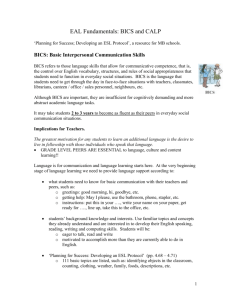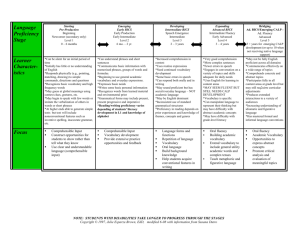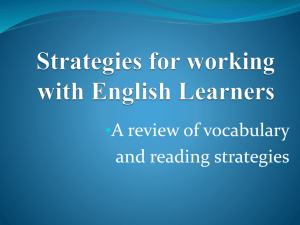BICS AND CALP = two different registers of English
advertisement
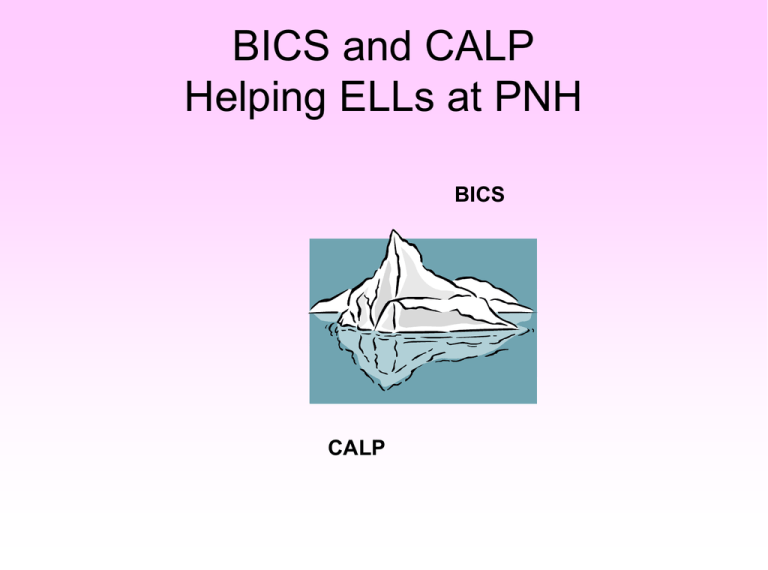
BICS and CALP Helping ELLs at PNH BICS CALP BICS AND CALP = two main registers (styles) of English (Cummins, 1979) • BICS = BASIC INTERPERSONAL COMMUNICATION SKILLS • (Breaks into a multitude of other registers) • CALP = COGNITIVE ACADEMIC LANGUAGE PROFICIENCY • Literature, reading skills, decoding difficult texts, making inferences, etc. BICS • Basic conversational fluency – buying food, asking for directions, social situations, even class discussions in some cases – students develop strategies to communicate • Can sound like a native speaker – especially if ss has developed use of idioms and back channeling (uh-huh, hmmm. Uh-uh, etc). • Mainstreamed too early • “She speaks fine, what is she doing in ESOL?” • You’ve been here ___ years and you’re still in ESOL???!! BICS • Takes 1-3 years to develop. • Develops first and develops according to social group/s. • Students may appear to “speak English,” but may struggle mightily with academic English register (most formal, proscribed, follows a restricted pattern, whereas BICS is more open and fluid) BICS v. CALP • BICS -Phonological development and basic fluency plateau at around 6 years of age – rate of subsequent development is slowed in comparison to previous development. • CALP – literacy and vocabulary knowledge continues throughout schooling and possibly throughout lifetime. (30 years ahead) Problem • Spoken English proficiency has been used as an indicator time and time again to determine placement for students – often they are placed in SSD classes and labeled with a disability, or they are mainstreamed and left to flounder with no ELL support based on a superficial assessment. Bumps in the Road • “Failure to take account of the BICS/CALP (conversational/academic) distinction has resulted in discriminatory psychological assessment of bilingual students and premature exit from language support programs (e.g. bilingual education in the United States) into mainstream classes (Cummins, 1984).” • LAS placement testing when students arrive helps • Students have to know that CALP development is a lifelong process. • Please help me educate the community on this point. Spectrum of Formal and Informal Register (Quirk et al. 1985) Very formal, ← FORMAL Neutral INFORMAL →Very informal, Frozen, Rigid Casual, Familiar EXAMPLES: EXAMPLES: Historical Documents Academic Papers Conversation http://www.mah.se/upload/Studieverkstaden/Formal%20and%20Informal%20English.doc Vertical and Horizontal Register • http://esl.about.com/od/advancedspeakingskills/a/v_register.htm ELLs can mix up the various registers, and it takes time for them, and specific feedback from you, to help them figure out the nuances of acceptable use within the target culture. Vertical Register = changes in formality in terms of speech and writing - static Horizontal Register = moving between and among peer groups and switching code to fit the groups Reflection: What would you say to a student who used slang/speech patterns/language that was inappropriate to the group/moment/task/social situation? How would you validate the student’s efforts but still provide them with some guidance about register use? Language in your classroom, office, etc. • There are often four or five different language registers used at the same time in a classroom. All of these registers are valid and meaningful to their users. • ELLs must negotiate meaning and figure out what register to use in various settings within one class period and then within one day! • (example of ss with shirt…, hey dawg…..) • What registers can you think of that are used in your classroom? Culture Question • A handshake in China should be ... -Limp and brief -Strong and lengthy -Firm but brief • Limp and brief! • Personal distance, personal contact CALP • Takes at least 5-7 years of immersion in academic environment. • Time frame can vary due to poor school attendance, family stress, economic stress, low schooling in L1, quality of school programs, health, learning differences, etc. • CALP is more deliberate, takes more time, must have more scaffolding – is key to success in HS and college. 7-10 Years • Recent research (Thomas & Collier, 1995) has shown that if a child has no prior schooling or has no support in native language development, it may take 7 to 10 years for ELLs to catch up to their peers. If students are below grade level in their native language, it takes at least 7-10 years for them to reach the 50th percentile. The likelihood of them catching up to their peers is very low. SLA Development • Both BICS and CALP can develop at the same time, but students often do not realize that even if they speak fairly well, that does not mean they can stop working on their language proficiency. • Learner awareness is key – students need to know that they are learning two different registers (at least), and that the CALP will take much longer. • Help me educate the community! Strategies for working on CALP • Give very clear feedback. It’s not enough to say ‘Clean this up,” or “What’s your point?” or “clarify.” • ELLs need much more specific feedback in order to understand what you expect from them. This builds the CALP schema for future success. • You could ask to see them after class (even if you have to with every assignment) for 3 minutes, and tell them what they need to do, or provide written directions…it may need to be more explicit at first, then you can ease up when you see improvement in their understanding of your expectations. (Surinsky example) More strategies • • • • Visuals, videos, photos, diagrams, lists Group projects 3D models What do you do in class that encourages CALP development in ELLs? • How can you help students differentiate between and among registers? Examples of Teacher Talk to ELLs • “Brian, remember NOT to use “I” or “you” in most formal essays. • Can you write three more complete sentences that explain the quote you chose? Why does it support the idea that Maya Angelou understood strength through her grandmother’s singing and silence? Tell me in your own words why you think this. Tell me first, and then write it down…..” • Rogelio, what specific ideas can you tell me about the Roosevelt and the Progressive movement? You need to be more specific with your facts….tell me 3 things that you could use to support your argument.. • Being more explicit takes a little more time, but it will make all the difference for these students! What can you do, What can I do? • Please communicate with me regularly on what is happening in your class, worries and concerns you have, etc. • Please allow ELLs extra time to complete assignments if necessary so that they can go through the editing process with me or another teacher. • Remember to provide specific, detailed written feedback combined with talking to the student after class to make sure they understand what you are asking of them. • Please feel free to call or email me anytime this year to set up some one-on-one time with students or with you. Student/Parent/Teacher Misconceptions • “You speak fine, why are you in ESL?” • “Her English is great, she won’t need your help.” • “Why am I here if I have been in the US for 7 years?” • “His English seemed fine so we…….” • “She’s from India, they speak English over there, so I’m sure she’ll be fine…” ELL program • We focus on CALP and scaffolding student understanding – success in any class • BICS will emerge with time and with peer interaction and immersion in target culture. • Multiple draft process – revision, conversation, intense support at beginning and less support as time goes by… • We try to instill in students the understanding that CALP development is a long process that does not stop with high school graduation. Culture Question • At a dinner in Hong Kong where will the guest of honour be seated? --To the left of the host --To the right of the host --Opposite the host • Opposite the host! Bibliography • Collier, Virginia and Wayne Thomas. • http://www.everythingesl.net/inservices/_long_does_take_learn_english_55843.php • Cummins, J. (1979) Cognitive/academic language proficiency, linguistic interdependence, the optimum age question and some other matters. Working Papers on Bilingualism, No. 19, 121-129. • http://eric.ed.gov/ERICWebPortal/custom/portlets/recordDetails/detailmini.jsp?_nfpb=true&_&ERICExtSearch_SearchValue_0=ED438551 &ERICExtSearch_SearchType_0=no&accno=ED438551 • http://www.iteachilearn.com/cummins/bicscalp.html • Halliday, M.A.K. and R. Hasan. 1976. • http://esl.about.com/od/advancedspeakingskills/a/v_register.htm • http://www.mah.se/upload/Studieverkstaden/Formal%20and%20Informal%20English.doc • Trudgill, 1992.
